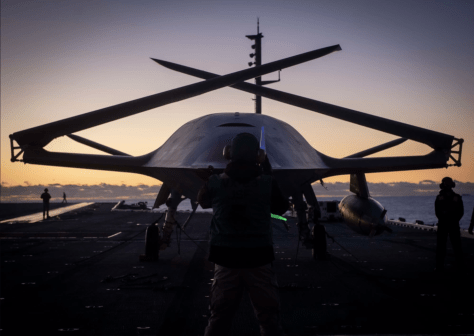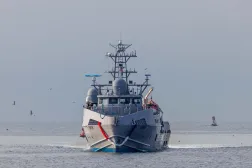Navy pursuing fixes for robo-ships after observing ‘inappropriate’ interactions at sea

The Navy has identified technology solutions to address problems encountered during recent deployments of maritime drones, according to a program manager.
The service has been developing and testing robo-ship prototypes to help the service prepare for a future “hybrid fleet” of crewed and uncrewed vessels. In recent months, it deployed several unmanned surface vessels (USVs) in the Pacific for Integrated Battle Problem 23.2 and other exercises. That effort generated data from thousands of hours of operations.
“One of our goals in prototyping is to put the vessels in as many diverse situations as we can. We want to explore … where the boundaries are, and in doing so bound the risk associated with unmanned operations,” Capt. Scot Searles, program manager for the Unmanned Maritime Systems Program Office (PMS 406), said during a briefing at the Surface Navy Association’s annual symposium.
That includes situations where USVs need to adhere to International Regulations for Prevention of Collision at Sea, or COLREGS.
“We’ve been successful there on this deployment with over 183 COLREGS interactions across the four vessels. Over 80% of the time, the autonomy handled those encounters exactly as everyone expected. Of the remainder, about half of those were considered questionable — meaning it did it okay, it was an absolutely appropriate response to a COLREGS interaction, [but] it’s just not what we would have expected it to do. And this is important to know because when unmanned ships are operating around manned ships, it’s not just about complying with COLREGS — it’s about behaving in a way that the other manned ships expect you to behave,” he said.
Searles used a self-driving car analogy to explain the issue of unexpected behaviors at sea.
“Think about if you’re driving down the highway and the unmanned car in front of you slams on its brakes because it’s perceived something that it needs to slow down for. Well, that’s not something you would necessarily expect. And the interaction of the manned-unmanned team is super important, and so we’re interested in those encounters. So even though [the USV] behaved in a way that is compliant with the COLREGS, we want to continue to investigate that and make sure that the vessels are blending in with the manned ships around them,” he said.
Additionally, the Navy observed 14 “inappropriate interactions.”
“It’s those 14 inappropriate interactions that we’re really interested in. That’s our real learning. That’s what we’re out there for. And that’s why we’re on deployment is to find those 14 interactions where we still need to go correct the software. So for us, it’s been an extremely valuable thing,” Searles said.
For example, “we found things like the antenna was blocked … and it got into a blind spot. And so the vessel master was tracking it into the blind spot but the ship in his opinion didn’t [do something] maybe quickly enough for the contact coming out of the blind spot. There was one where rough seas were making them want to navigate on a particular heading, and as they got on the heading, they started getting more and more false contact and making the ships do more and more reactions, more and more COLREGS maneuvering” when they didn’t need to, Searles told DefenseScoop.
“Occasionally, the things we wanted it to do, like stay in this box or stay relative bearing and distance, it struggled to return to that. So that tells us OK, there’s something in that feedback loop that we need to go tweak. So that’s kind of the flavor of what those 14 were,” he added.
The Navy is gleaning important information about how the autonomy technology is handling problems like limited visibility and an inability to correlate visual tracks with radar contacts.
For example, heavy rain on a maritime drone’s perception system can make a wave or rain cloud look like a solid object that needs to be avoided. That tricks the robo-ship into unnecessary maneuvering, Searles explained.
The Navy is currently developing two optical systems to address that problem, he noted, and it plans to use artificial intelligence to help the platforms distinguish false contacts from real obstacles. The service hopes to field both of those prototypes on USVs for testing by the end of this year.
During the IBP 23.2 exercise that just wrapped up, there were 157 distinct human interventions during the robo-ships’ operations. However, 109 of those were unrelated to autonomy and were associated with off-ship command, control, communications, computers and intelligence (C4I) issues that required someone to be on the USV to troubleshoot — or other “matters of human convenience,” according to Searles.
Among the 48 “interventions of concern,” 17 were related to sensing and perception, nine were related to maneuvering decisions, 11 were related to hull mechanical and electrical systems, and the rest were due to weather or other factors.
“We’re down to about 48 human interventions of concern that we need to do something about … And that works out to be an intervention about once every 42 hours. So, [we’re] getting better but your unmanned ship still needs a human every two days now. So, still not happy with that,” he said.
The mean time between human interventions to deal with perception and autonomy-related issues is about once every four days, he noted.
The Navy continues to learn as it gains more experience deploying the USVs and putting them through their paces at sea.
“The vessels have demonstrated successful responses to many of the things that [Surface Development Squadron 1] is going to need it to do in tactical employment — pause, resume, vector, hover, loiter, station keeping, transit, towing, drift — all of those things that are important to actually tactically employ these vessels in concert with another Navy manned ship. So again, really good learning opportunities both for the acquisition program office as we try to develop the technology, test that technology, as well as the CONOPS development and the CONEMP development,” Searles said, using acronyms to refer to concept of operations and concept of employment.
“The deployment has provided data that’s gonna keep us busy for a while. We’ve got a good backlog of things to work on now. But it’s also given us a very good fix that we’re pretty happy about it on our roadmap to fielding unmanned [vessels]. We feel like we’re right where we need to be and right on the right glide slope. We’re very pleased with where it’s shown we’re at on our roadmap, and we’re looking forward to the future hybrid fleet,” he said.






